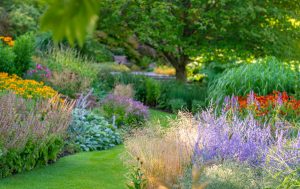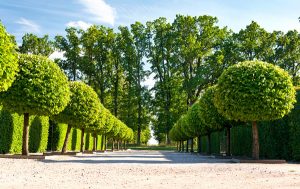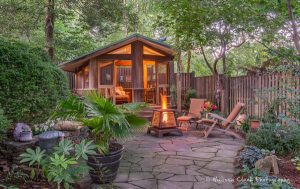Top landscape trends for all terrains
Take a look at these design trends for sophisticated landscapes, then learn about insuring your outdoor space
When you look out at your backyard or the greenery on your terrace, do you see vegetal order or chaos? Perhaps you don’t see any green, but rather a landscape of rocks and cacti. Or perhaps you have plans to hire a landscape architect or commission a sculpture for your backyard. Whatever your climate, desired commitment, or personal taste, it may include one of today’s top landscape trends for outdoor spaces.
Homeowners are passionate and particular about their plots of land, and options for garden designs are ever-expanding. Whether you want to create a paradise garden, display ornate topiaries or attract the birds and the bees, there are numerous possibilities for today’s backyards and balconies. Here are three of the today’s top design trends to transform your space, along with some tips to help make sure it’s properly protected.
1. Drought tolerant gardens

Drought-tolerant gardens are on-trend and can make for vibrant and beautiful scenery.
Weather challenges in numerous parts of the country have encouraged homeowners to select plants with low water requirements. Drought tolerant planting is also known as Xeriscaping. “Xeriscaping” may connote that you are “deleting” the idea of landscaping, but the word is actually derived from the Greek xeros, meaning dry. It is the practice of designing landscapes to reduce or eliminate the need for irrigation.1
If images of rocks with a few succulents come to mind, think again. A drought resistant garden can be sumptuous and full of textures, colors and design. In the 1970s, Ruth Bancroft was a pioneer of artistically designed drought resistant gardens.
Bancroft took a focused approach to her garden’s design. She’d begin with the largest plant as the main focal point, like a five-foot high agave, and fill out the garden’s design around the main plant. Shrubs of medium size would come next, and finally she would add the garden’s smallest flora, all the while taking into consideration plant, color and texture.
Brian Kemble, curator of the Ruth Bancroft Garden in Walnut Creek, California, shares Bancroft’s design philosophy. “At each stage, be conscious of how the new (plants) play off what’s already there. Do the colors contrast? Or do they complement one another?” he explains in Architectural Digest. “With each step it gets more complicated, because there are more things to consider, but it allows you to paint with plants.”2
This notion of painting with plants actually refers to the importance of design in the landscaping process. There are a variety of drought tolerant trees, shrubs and ground covers that can create a colorful horticultural canvas suitable for your climate, so it is important to speak with a local gardener about which plants are appropriate for your geography. Though a Yucca tree may be beautiful in Arizona in the garden of your seasonal desert retreat, it may not survive a winter in Connecticut.

Pollinator gardens can come in many different styles, but often feature bright pops of color thanks to wildflowers.
2. Pollinator gardens
Painting with plants is especially easy with a palette of wildflowers. A natural style of garden design—with rolling hills, wildflowers and reflecting lakes—first became popular in Great Britain in the mid-1700s. Today, this popular approach to landscape design often has an ecological underpinning.
Bees, butterflies, birds and other pollinators play an important role in maintaining the fertility of fruit trees and agricultural crops. According to the US Department of Agriculture, some scientists believe as much as 1/3 of our food depends on such pollination.3 Many gardeners who wish to protect pollinators and provide “food” and nest sites today are turning to pollinator gardens to help bring back the dwindling numbers of these important invertebrates and ensure that our apple, peach and almond trees continue to thrive.
How do you create a pollinator garden? By creating a space that offers what these creatures need. For example, if you would like to attract more Monarch butterflies to your yard, it is important to offer both nectar (for food) and host plants (for shelter) for these creatures.4 Resources like www.xerces.org offer pollinator-friendly plant lists listed by geographic region of the USA, which can help aspiring gardeners get started.

Specimen trees, like these ornamental topiary green trees, are starring in more and more sophisticated landscapes.
3. Specimen trees
The opposite of the bucolic rambling garden is the meticulously-curated garden, best-exemplified by the gardens surrounding French chateaus in the 1700s. Think of the highly manicured tresses of trees, shrubs and topiaries at Versailles and Fontainebleu.
One landscape trend of today that nods to these grand, manicured gardens is the popularity of specimen trees. These are unique, large or old trees that become the focal point of your landscape design. A specimen tree could be a Japanese willow, a ten-foot high cactus, a row of Italian cypresses that evoke a villa on Lake Como, or a collection of topiaries that mimic the French masters.
Selecting a feature like this as the star of your setting is the kind of landscaping decision that is often made with a landscape architect who takes into account your garden’s acreage, climate and purpose.
“Garden designers bring a deep understanding of space, architecture, aesthetics, and human movement to your property. Focal points draw and direct the eye through the garden: a specimen tree that is properly scaled can make your garden sing. Specimen trees can range from $1,500 to the tens of thousands of dollars,” says Cathy Carr, FAPLD, founder and principal designer at GreenHeart Garden Designs, a firm that has designed many of the sprawling backyards and elegant city gardens in the Washington, DC metro area. For inspiration or aspiring horticulturists, sites like Houzz or Gardenista offer design options for balconies and backyards built around a showcase specimen plant.

There’s a lot to consider when it comes to insuring landscapes, hardscapes and freestanding outdoor structures like this welcoming pavilion. Image: Courtesy of GreenHeart Garden Designs.
Insuring your landscape
In a heavy thunderstorm, lightning strikes down your one-hundred-year-old oak tree or your unicorn topiary. How will you replace it? With the right insurance provider, you may be financially reimbursed to replace that special tree, shrub or plant.
Proper care for your landscape should include two components: insurance coverage and risk management. The former includes understanding how the elements of your space are covered by your homeowners’ insurance, and the second includes steps you can take to help protect your outdoor environment and make a loss less likely to occur.
Insurance coverage for your landscape:
Ask your independent insurance agent about whether your homeowners’ policy provides any specialized coverage for landscaping. At Berkley One, we provide coverage for landscaping which includes up to $5,000 for any one tree, shrub or plant that is damaged by a covered peril. Depending on the state, you may also have options to increase the amount of landscaping coverage, increase the per item value of that tree, plant or shrub or add additional covered perils.
Pagodas, pavilions, gazebos and guesthouses:
An important reminder if you are building pagodas or free-standing outdoor structures is that these can be insured as other structures on your policy. Contact your independent agent (you can find a Berkley One agent here!) to help you help navigate the details of coverage for your landscaping and hardscaping.
A little TLC goes a long way:
During a windstorm, fallen trees cause the most damage to homes and property—not to mention the cost of replacing the eucalyptus tree. A good risk manager can provide ongoing advice and assistance. At Berkley One, we can also connect you with a qualified arborist to review your property with an eye on protecting your landscape and home.
Whether or not these landscape design trends make it into your backyard, designing your outdoor space can be a relaxing endeavor for the hobby gardener, or a way to realize your dream of foliage, ferns and free-time with the help of a seasoned professional. The investment in time, labor and expense is rewarded by relaxing in a paradise garden of your own definition—whether it serves as your private, restful retreat or a space for outdoor entertaining that’s the talk of the town.
Katja Zigerlig is Vice President, Art Wine + Collectibles Advisory at Berkley One (a Berkley Company).
Header Image: Courtesy of GreenHeart Garden Designs.



